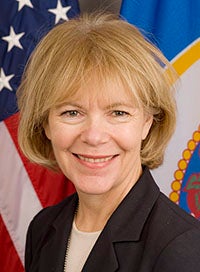Communities can’t wait longer for broadband
Published 9:21 am Monday, February 1, 2016
Guest Column by Tina Smith
Minnesota’s rural communities are the economic and cultural backbone of our state. Rural communities provide Minnesotans with good job opportunities in a diverse range of industries from farming to forestry, and machinery to medical research. These towns power Minnesota’s economy beyond their borders. Simply put, the success of Greater Minnesota and the success of Minnesota are completely connected.
That’s why Gov. Dayton and I are committed to making investments this session that strengthen rural communities. One of our biggest priorities is $100 million for border-to-border broadband Internet access. During the past two years, we’ve worked with the Legislature to invest $30 million in rural broadband access — benefiting 9,317 households, 173 community institutions and 936 businesses.
But, we know the need is far greater. Last year, I met with Minnesotans from across the state to talk about the importance of broadband access and the great lengths they go to get it. In the Central Lakes area, a cancer doctor told about how he drives from his home to a McDonald’s parking lot in town, just so he can download patient X-rays. While a commodities trader, living near Fergus Falls, said he was able to run a global trading business from a farmhouse once owned by his wife’s grandparents because he does have access. And the Roseau Schools superintendent told me about a Wi-Fi-enabled bus they use to help students finish their assignments because they lack access at home.
Stories like these underscore the importance of high-speed Internet access to our state’s economy and quality of life. Currently, 221,000 rural Minnesota households lack access to broadband that meets the state’s minimum speed goals.
The economic benefits of border-to-border broadband access are clear. In 2014, the Greater Minnesota Partnership reported that 95 percent broadband coverage across the state would create significant benefits, including $440 million in additional household income, 15,000 jobs created or sustained and more than $1 billion in state GDP growth. And more than that, expanding broadband access will unleash the innovative spirit of rural Minnesotans. Border-to-border access will help doctors provide better care, entrepreneurs grow their businesses, and students finish homework at home, instead of on the bus.
The $100 million plan that Gov. Dayton and I have proposed would jumpstart the state’s rural broadband access effort and would help us get closer to the goal of border-to-border access. It’s estimated that this investment would provide broadband access to 35,000 additional homes, businesses and institutions across Minnesota.
I hope we can count on your support this session. Please contact your legislators and urge them to support new broadband investments. It’s too important to our communities to wait any longer. Let’s work together to build out a border-to-border network and create an economy that works for everyone, everywhere in Minnesota.
Tina Smith is Minnesota’s lieutenant governor.


